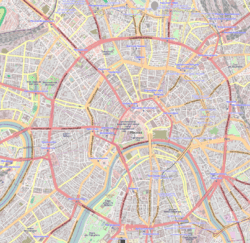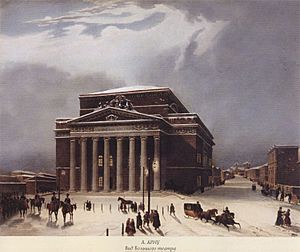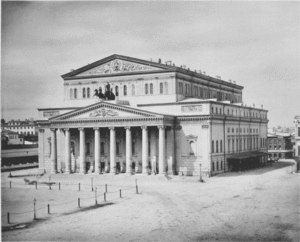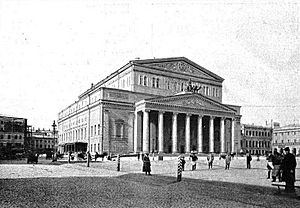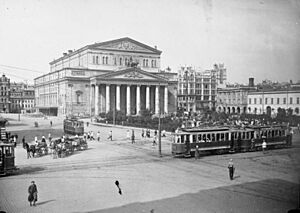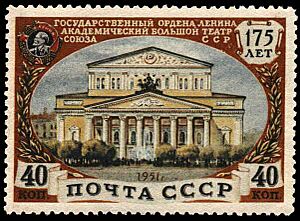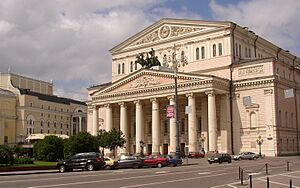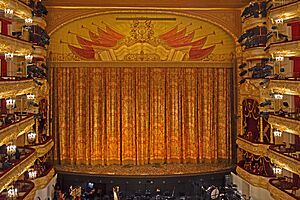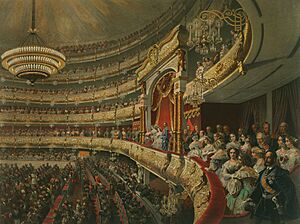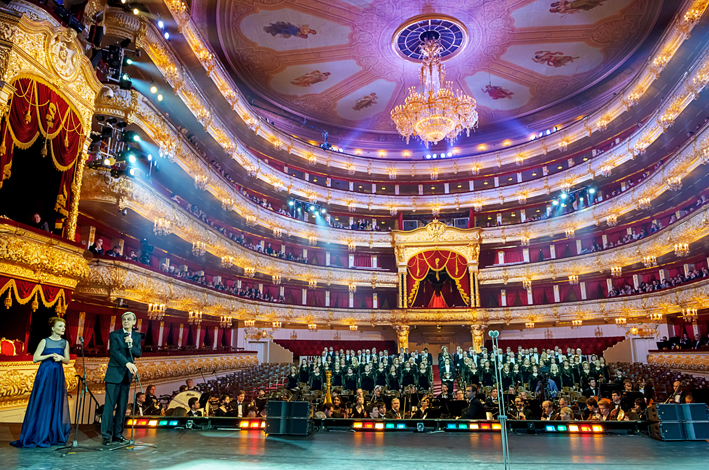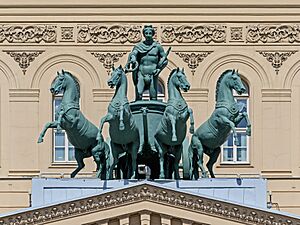Bolshoi Theatre facts for kids
|
Большой театр
|
|
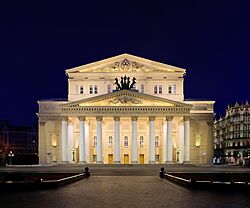
Bolshoi Theatre
|
|
| Address | Teatralnaya Square 1, Tverskoy District, Moscow, Russia |
|---|---|
| Coordinates | 55°45′37″N 37°37′07″E / 55.76028°N 37.61861°E |
| Public transit | Teatralnaya or Okhotny Ryad (Moscow Metro) |
| Capacity | 1,740 |
| Construction | |
| Opened | 1825 |
| Architect | Joseph Bové |
The Bolshoi Theatre (Russian: Большо́й теа́тр, tr. Bol'shoy teatr, IPA: [bɐlʲˈʂoj tʲɪˈat(ə)r], lit. 'Grand Theater') is a famous opera house in Moscow, Russia. It was first designed by the architect Joseph Bové. Before the Russian Revolution, it was part of the Imperial Theatres of the Russian Empire.
The Bolshoi Ballet and Bolshoi Opera are two of the oldest and most famous ballet and opera groups in the world. The Bolshoi Ballet is the largest ballet company globally, with over 200 dancers. The theatre also has its own ballet school, The Bolshoi Ballet Academy.
The main building of the theatre has been rebuilt and fixed many times. It is a well-known symbol of Moscow and Russia. Its classic-style front is even shown on the Russian 100-ruble banknote. In October 2011, the Bolshoi Theatre reopened after a big six-year renovation. This project cost a lot of money. The renovation made the sound quality (acoustics) as good as it was originally. It also brought back the beautiful old decorations inside.
Contents
History of the Bolshoi Theatre
How the Bolshoi Started
The Bolshoi company began on March 28, 1776. This was when Catherine II of Russia gave Prince Peter Urusov permission to create theatre shows and other fun events. Urusov worked with an English tightrope walker named Michael Maddox.
At first, performances were held in a private house. Later, they got the Petrovka Theatre. On December 30, 1780, they started putting on plays and operas there. This was the start of what would become the Bolshoi Theatre. Sadly, the Petrovka Theatre burned down in 1805. A new theatre replaced it in 1808, but it also burned down during a French invasion in 1812.
The current theatre building was constructed between 1821 and 1824. Joseph Bové designed and oversaw its building. It opened on January 18, 1825, with a ballet called Cendrillon. At first, only Russian works were performed. But around 1840, works by foreign composers were added.
Repairs in the 1800s
In 1843, the theatre had a major reconstruction. But a fire in 1853 caused a lot of damage. So, another big repair was done by Alberto Cavos.
The 1900s at the Theatre
On December 7, 1919, the theatre was renamed the State Academic Bolshoi Theatre. A few days later, there was an attempt to close it completely, but it failed. A new hall, Beethoven Hall, opened in 1921. More repairs were done between 1921 and 1923. During World War II, a bomb damaged the building, but it was fixed.
New Stage Opens in 2002
A new stage for the Bolshoi Theatre, called the New Stage, opened on November 29, 2002. It was built next to the historic main stage. This new building, along with other smaller buildings, forms one big theatre complex. It is called the Bolshoi Theatre of Russia.
Big Renovation from 2005 to 2011
From July 2005 to October 2011, the theatre was closed for a huge restoration. The building was old and needed many repairs. Engineers found that most of the building was not stable. The renovation was paid for by the government.
During this long repair time, the theatre company still performed. They used the New Stage and the stage at the Great Kremlin Palace. The renovation brought back the original sound quality. It also restored the beautiful old decorations from the time of the Russian Empire. After the renovation, the theatre can hold 1,740 people. On October 28, 2011, the Bolshoi Theatre reopened with a concert. The first opera performed after the renovation was Ruslan and Lyudmila.
Famous First Performances
The Bolshoi Theatre has been the place for many important first performances, including:
- Tchaikovsky's The Voyevoda and Mazeppa
- Modest Mussorgsky's version of Boris Godunov in 1888.
- Rachmaninoff's Aleko and Francesca da Rimini
- Nikolai Rimsky-Korsakov's opera The Maid of Pskov, with Feodor Chaliapin singing the role of Ivan the Terrible
- Dmitri Shostakovich's opera Lady Macbeth of the Mtsensk District in 1935.
Other Interesting Facts
- The first concert by the Bolshoi Orchestra was on May 4, 1919.
- During the COVID-19 pandemic, some members of the theatre got sick.
Ballet and Opera at the Bolshoi
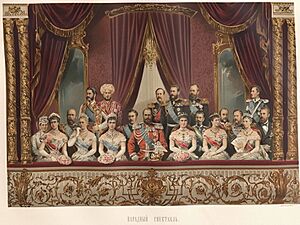
The Bolshoi is a repertory theatre. This means it has a list of shows it can perform, and any one of them might be shown on a given night. The Bolshoi has always been known for its ballet. Tchaikovsky's famous ballet Swan Lake first premiered at the theatre on March 4, 1877.
After the death of Joseph Stalin, the company started touring around the world. This made the "Bolshoi Ballet" very famous in other countries. Some dancers from the Bolshoi later moved to other companies. The Bolshoi still tours regularly with its opera and ballet shows.
Until the mid-1990s, most foreign operas were sung in Russian. But now, you can hear operas sung in Italian and other languages more often. In 2024, the Bolshoi's Ballet is considered one of the best in the world. Its production of The Nutcracker is seen as the original and best version.
The Bolshoi Orchestra
The music director and chief conductor, Vassily Sinaisky, left his position in December 2013. Tugan Sokhiev took over in January 2014. Sokhiev later left his role in connection with the 2022 events in Ukraine. In December 2023, Valery Gergiev was chosen as the new artistic director.
Chief Conductors and Music Directors
- Samuil Samosud (1936–1942)
- Ariy Pazovsky (1943–1948)
- Nikolai Golovanov (1948–1953)
- Alexander Melik-Pashayev (1953–1963)
- Yevgeny Svetlanov (1963–1965)
- Gennady Rozhdestvensky (1965–1970)
- Yuri Simonov (1970–1985)
- Alexander Lazarev (1987–1995)
- Peter Feranec (1995–1998)
- Mark Ermler (1998–2000)
- Gennady Rozhdestvensky (2000–2001)
- Alexander Vedernikov (2001–2009)
- Leonid Desyatnikov (2009–2010)
- Vassily Sinaisky (2010–2013)
- Tugan Sokhiev (2014–2022)
- Valery Gergiev (2023–present)
Cultural Importance
The Bolshoi Theatre is a very popular place for tourists to visit. Because of this, tickets can be more expensive than at other theatres in Russia.
See also
 In Spanish: Teatro Bolshói (Moscú) para niños
In Spanish: Teatro Bolshói (Moscú) para niños
- List of productions of Swan Lake derived from its 1895 revival


